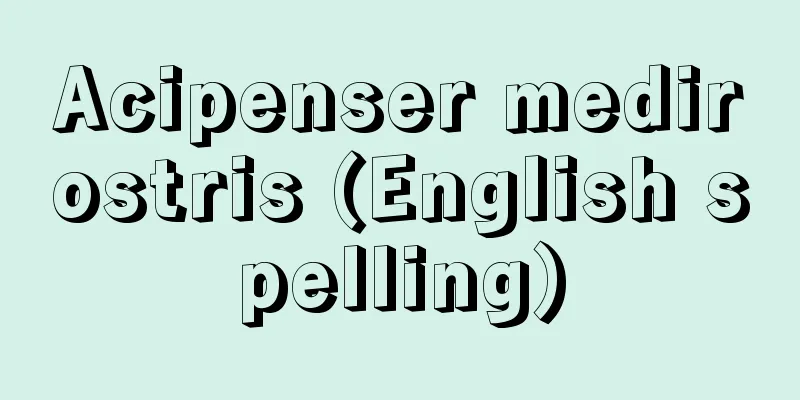Idea - Kannen (English spelling) idea English

|
A term referring to the mental representations that humans have of things. It is generally used to refer to a wide range of representations in general, from sensory or imaginative representations to rational or intellectual representations, or to either of these. As a philosophical term, its original usage is to mean intellectual representations or concepts, or even complexes of these, as opposed to sensory or perceptual representations. [Megumi Sakabe] Ancient and medieval usageAll modern European words that correspond to idea originate from the Greek word idea, which also originates from idein (to see) and originally had the meaning of something seen, form, or shape. It was Plato who introduced it as a philosophical term, giving it a unique meaning. In other words, he called the name of idea not an individual thing as an object of relative perception, but an eternal, universally valid reality grasped by intellectual cognition, based on the two-world metaphysics that distinguishes the physical, sensory world and the spiritual, supersensible world inherited from Orphism through Pythagoreanism. Ideas are not only true entities, but also bear value-normative meanings as the prototypes of all things, and this character reaches its peak in the "idea of the good," which is said to be the pinnacle of all ideas. From the viewpoint of the individual things in the sensible world, they are said to have reality only insofar as they share the Idea, which is their prototype. Aristotle, while critically inheriting Plato's idea, regarded individual things as a combination of Form (eidos) and Matter (huūleē), and set out to consider the generation of things as a transition from potentiality to actuality, but even here, the normative character of Form as the determination of the essence of things was still utilized in some form. Plato's philosophy was inherited particularly through Neoplatonism, and Aristotle's philosophy was inherited in large part by Christian philosophy from the end of antiquity to the Middle Ages, via the philosophy of the Arab cultural sphere. Here too, the Idea or Form was inherited as the supersensible prototype of the things of the world in the intellect of the Creator God, preserving its high degree of reality and normativity. However, in the "universals debate" over the issue of whether reality should be given to universals or to particular things, the nominalist side, which denies the existence of universals, also took the approach of thinking of ideas as secondary products, following the epistemology of ancient materialism. [Megumi Sakabe] New developments in the early modern periodIn the nominalist view, which had come to have a widespread influence toward the end of the Middle Ages, a view had already emerged that regarded ideas as representations, thoughts, and contents of consciousness that appear in the human mind. This direction gained strength in the early modern period as the theocentric view shifted to an anthropocentric approach to considering phenomena starting from human consciousness, and the usage of the word "idea" that continues to this day was established. This shift in usage was seen in Descartes, who divided ideas into three types: (1) sensory ideas that the mind receives from the outside world, (2) imaginative ideas that the mind creates by itself, and (3) innate ideas that are inherent in the human mind. However, it was none other than Locke who took a decisive step in the early modern treatment of issues related to ideas by denying the existence of the third type of innate ideas. That is, Locke assumed "sensation" and "reflection" as the components of experience, and attempted to explain human cognitive activity through the acquisition of "simple ideas" and the synthesis of "compound ideas" through these. This empirical method was further developed by Hume in England, and in France it was expanded from Condillac's theory of sensation to the ideology of Destutt de Tracy and others. On the other hand, it should not be overlooked that there were people in the early modern period who, while following the footsteps of Descartes-Locke, were somehow connected to the Platonic idea of ideas, such as Berkeley in England, and Malebranche and Maine de Biran in France. [Megumi Sakabe] Today's IssuesLocke, who denied the idea of intrinsic ideas and tried to explain the generation of experience through the mechanism of the acquisition and synthesis of ideas, naturally focused on the role of language in the formation and development of human cognition and presented the concept of semiotics (semeiotike), but this concept was nothing other than something inherited from the ancient Epicureans through medieval nominalism. Today, semiotics or semiology is being given a new look with various modern techniques and is showing signs of a revival, but it is in this field that new developments in thinking about the problem of ideas can be seen and expected. For example, as can be seen in the debate between Chomsky and Piaget over the existence of intrinsic ideas, the ancient problem of ideas is repeated in the context of new academic research, and it can be seen that the problems that existed since Plato and Epicurus are still alive today. [Megumi Sakabe] "Plato" by Shinzui Saito (Iwanami Shinsho)" ▽ "The Intellectual Heritage of Mankind 20: Thomas Aquinas" by Yoshinori Inagaki (1979, Kodansha)" ▽ "World Masterpieces 27: An Essay on the Human Understanding" by John Locke, translated by Haruhiko Otsuki (1968, Chuokoron-Shinsha) Source: Shogakukan Encyclopedia Nipponica About Encyclopedia Nipponica Information | Legend |
|
人間があるものについて心中にもつ表象を指示する用語。一般的には、感覚的あるいは空想的表象から理性的、知的表象にまで及ぶ広い範囲の表象一般、あるいはそのいずれかをさすものとして使われる。哲学の術語としては、感覚的あるいは感性的表象に対立するものとして、知的表象ないしは概念、さらにはその複合体を意味するのが本来の用法である。 [坂部 恵] 古代・中世における用法近代ヨーロッパ諸語での観念に相当することばは、すべて、ギリシア語のイデアideaに由来し、この語はまたidein(見る)に由来するものとして、元来、見られたもの、姿、形といった意味をもっていた。これを哲学用語として独特の意味をもたせて導入したのはプラトンである。すなわち、彼は、オルフェウス教からピタゴラス主義を通して受け継がれた肉体にとらわれた感覚的世界と霊的な超感覚的世界をたてる二世界論的な形而上(けいじじょう)学を背景に置きながら、相対的な知覚の対象としての個物でなく、知性的認識によって把握される永遠の普遍妥当的な実在をイデアの名でよんだのである。イデアは、単に真実在としてのみならず、諸物の原型として、価値的規範的意味を担い、この性格は、諸イデアの頂点に位するとされる「善のイデア」において極まる。感覚的世界の個物の側からみれば、それらは、その範型であるイデアにあずかる限りにおいて実在性を得るとされるのである。アリストテレスは、このプラトンの考えを批判的に継承しつつ、形相eidosと質料huūleēの結合として個物をとらえ、可能態から現実態への移行として事物の生成を考える方向を打ち出したが、ここでもなお、形相が事物の本質規定をなすという規範的性格はある形で生かされていた。プラトンの哲学はとりわけ新プラトン主義を介して、また、アリストテレスの哲学は、その主要部分をいったんアラブ文化圏の哲学を仲介して、古代末から中世にかけてのキリスト教哲学に受け継がれるが、ここでも、イデアないし形相は、創造神の知性における世界の諸事物の超感覚的原型として、その高い度合いにおける実在性、規範性という性格を保存したままで継承された。とはいえ、普遍概念と個物のどちらに実在性を与えるべきかという問題をめぐる「普遍論争」において、普遍概念の実在を否定する唯名論の側には、古代唯物論の認識論を継いで、観念を二次的生成物として考える方向もまたみられた。 [坂部 恵] 近世における新たな展開中世末期に至って広く影響を及ぼすようになった唯名論の考えのなかに、すでに、観念を人間の心に現れる表象、想念、意識内容とみなす見方が現れていたが、この方向は、近世に入り、神中心的な見方が、人間中心的に人間の意識を出発点として事象を考察する行き方に転換するとともに力を得て、観念の語の今日に至る用法がここに確立された。この用法の転換は、観念を(1)心が外界から受け取った感覚的観念、(2)心が自分でつくりだした想像的観念、(3)人間の心に生来備わっている本有観念の3種に分けて考えるデカルトにおいてみられるが、このうち第三の本有観念の存在を否定して観念にかかわる問題の近世的な取扱いに決定的な一歩を踏み出したのはロックにほかならない。すなわち、ロックは、経験の構成成分として「感覚」と「反省」を想定し、それらによる「単純観念」の取得と「複合観念」の合成の働きによって、人間の認識活動を説明することを試みたのである。この経験論的手法は、イギリスではヒュームによってさらに徹底され、フランスではコンディヤックの感覚論からデスチュット・ド・トラシらの観念学(イデオロジー)にまで展開された。一方、デカルト―ロックの流れに出ながら、イギリスのバークリー、フランスのマルブランシュ、メーヌ・ド・ビランら、プラトニズム的なイデアの考えになんらかの形で連なる人々が近世においてもみられることも見落としてはならない。 [坂部 恵] 今日における諸問題本有観念を否定し観念の取得と合成のメカニズムによって経験の生成を解き明かそうとしたロックは、人間の認識の形成と展開において言語の占める役割に当然のことながら注目し、記号学(セーメイオーティケー)の構想を示したが、この構想は、古代のエピクロス学派から中世の唯名論を通して受け継がれたものにほかならなかった。今日、記号論ないし記号学は、さまざまな現代的手法によって装いを新たにして、復権の機運をみせているが、観念の問題をめぐる新たな思考の展開は主としてこの領域にみられ、また期待もされるといえよう。たとえば、本有観念の有無をめぐるチョムスキーとピアジェの論争などにみられるように、観念をめぐる古来の問題が、新たな学的探究の文脈のうえに繰り返されることから、プラトンやエピクロス以来の問題が今日なお生きていることが観取される。 [坂部 恵] 『斎藤忍随著『プラトン』(岩波新書)』▽『稲垣良典著『人類の知的遺産20 トマス・アクィナス』(1979・講談社)』▽『ロック著、大槻春彦訳『世界の名著27 人間知性論』(1968・中央公論社)』 出典 小学館 日本大百科全書(ニッポニカ)日本大百科全書(ニッポニカ)について 情報 | 凡例 |
<<: Conceptual novel - Kannen Shosetsu
>>: Battle of Cannae - Battle of Cannae
Recommend
Monotropa uniflora (English spelling) Monotropauniflora
...It is distributed in the Kuril Islands, Sakhal...
"Kyoraikotomondou" - Kyoraikotomondou
...This book is a controversial response to quest...
Safety breaker - Anzenbureika
...A type of wiring circuit breaker used to prote...
Tatebayashi Domain
This was a Fudai clan whose headquarters was Tate...
α-Cyanohydrin - Alpha Cyanhydrin
...A general term for compounds that have both a ...
Commercial transaction
A commercial transaction. (New English-Japanese Di...
STAB
…King of matches. He started out as an engineer, ...
Middle-aged man - Middle-aged man
〘noun〙① A person whose talents and abilities are a...
Berlin, B. (English spelling) BerlinB
…It seems certain that the meaning of the same wo...
Rossi, B. (English spelling) RossiB
…X-ray astronomy began in 1962-63 when Americans ...
Kim Van Kieu
A long Vietnamese epic poem written in Chinese and...
well-done
...Then, adjust the heat depending on the quality...
Old woman - Uba
...There were also many cases in which a special,...
Radiolarite
...Species such as the Japanese hominin Acanthome...
Strawberry genus - Strawberry genus
...Originally native to Eurasia, the North Americ...

![Chihayaakasaka [village] - Chihayaakasaka](/upload/images/67cc2f1f24a93.webp)


![Namiai [village] - Namiai](/upload/images/67cc67f81f78c.webp)




